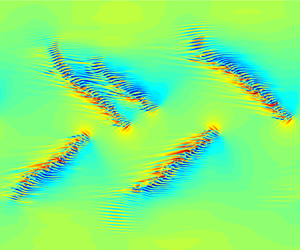Crossref Citations
This article has been cited by the following publications. This list is generated based on data provided by
Crossref.
Xiao, Xiangkai
and
Song, Baofang
2020.
Kinematics and Dynamics of Turbulent Bands at Low Reynolds Numbers in Channel Flow.
Entropy,
Vol. 22,
Issue. 10,
p.
1167.
Liu, Chang
and
Gayme, Dennice F.
2021.
Structured input–output analysis of transitional wall-bounded flows.
Journal of Fluid Mechanics,
Vol. 927,
Issue. ,
Kashyap, Pavan V.
Duguet, Yohann
and
Dauchot, Olivier
2022.
Linear Instability of Turbulent Channel Flow.
Physical Review Letters,
Vol. 129,
Issue. 24,
Parente, E.
Robinet, J.-Ch.
De Palma, P.
and
Cherubini, S.
2022.
Linear and nonlinear optimal growth mechanisms for generating turbulent bands.
Journal of Fluid Mechanics,
Vol. 938,
Issue. ,
Wu, Haoyang
and
Song, Baofang
2022.
A numerical study of the side-wall effects on turbulent bands in channel flow at transitional Reynolds numbers.
Computers & Fluids,
Vol. 240,
Issue. ,
p.
105420.
Parente, E.
Robinet, J.-Ch.
De Palma, P.
and
Cherubini, S.
2022.
Minimal energy thresholds for sustained turbulent bands in channel flow.
Journal of Fluid Mechanics,
Vol. 942,
Issue. ,
Kohyama, Kazuki
Sano, Masaki
and
Tsukahara, Takahiro
2022.
Sidewall effect on turbulent band in subcritical transition of high-aspect-ratio duct flow.
Physics of Fluids,
Vol. 34,
Issue. 8,
Xu, Duo
and
Song, Baofang
2022.
Size-dependent transient nature of localized turbulence in transitional channel flow.
Journal of Fluid Mechanics,
Vol. 950,
Issue. ,
Shuai, Yu
Liu, Chang
and
Gayme, Dennice F.
2023.
Structured input–output analysis of oblique laminar–turbulent patterns in plane Couette–Poiseuille flow.
International Journal of Heat and Fluid Flow,
Vol. 103,
Issue. ,
p.
109207.
Zhai, Xueyan
Chen, Kaiwen
and
Song, Baofang
2023.
Linear instability of channel flow with microgroove-type anisotropic superhydrophobic walls.
Physical Review Fluids,
Vol. 8,
Issue. 2,
2023.
Nonlinear optimal perturbations and formation mechanism of localized wave packet in channel flow.
Physics of Fluids,
Vol. 35,
Issue. 5,
SONG, BaoFang
2025.
Spatio-temporal intermittency and phase transition in the subcritical transition of shear flows: Current status and open problems.
SCIENTIA SINICA Physica, Mechanica & Astronomica,
Vol. 55,
Issue. 1,
p.
214701.

 $Re\simeq 500$. More importantly, we can generate any band patterns with desired relative position and orientation. The usual perturbation approach resorts to turbulent fields simulated at higher Reynolds numbers, random noise or localised vortical perturbation, which neither assures a successful generation of bands at low Reynolds numbers nor offers a control on the orientation of the generated bands. A precise control on the position and orientation of turbulent bands is important for the investigation of all possible types of band interaction at low Reynolds numbers and for understanding the subcritical transition in channel flow.
$Re\simeq 500$. More importantly, we can generate any band patterns with desired relative position and orientation. The usual perturbation approach resorts to turbulent fields simulated at higher Reynolds numbers, random noise or localised vortical perturbation, which neither assures a successful generation of bands at low Reynolds numbers nor offers a control on the orientation of the generated bands. A precise control on the position and orientation of turbulent bands is important for the investigation of all possible types of band interaction at low Reynolds numbers and for understanding the subcritical transition in channel flow.